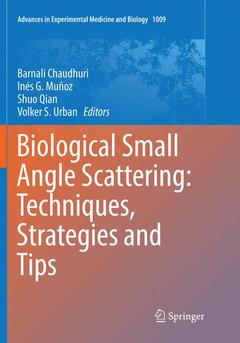Biological Small Angle Scattering: Techniques, Strategies and Tips, 1st ed. 2017 Advances in Experimental Medicine and Biology Series, Vol. 1009
Coordonnateurs : Chaudhuri Barnali, Muñoz Inés G., Qian Shuo, Urban Volker S.

The book is written by leading experts in solution SAS methodologies. The principles and theoretical background of various SAS techniques are included, along with practical aspects that range from sample preparation to data presentation for publication. Topics covered include techniques for improving data quality and analysis, as well as different scientific applications of SAS. With abundant illustrations and practical tips, we hope the clear explanations of the principles and the reviews on the latest progresses will serve as a guide through all aspects of biological solution SAS.
The scope of this book is particularly relevant for structural biology researchers who are new to SAS. Advanced users of the technique will findit helpful for exploring the diversity of solution SAS methods and applications.
Chapter 3 of this book is available open access under a CC BY 4.0 license at link.springer.com.
Sample and Buffer preparation for SAXS.- Considerations for sample preparation using size-exclusion chromatography.- How to analyze and present SAS data for publication.- Designing and Performing Biological Solution Small-Angle Neutron Scattering Contrast Variation Experiments on Multi-component Assemblies.- SAS-based structural modeling and model validation.- Structural Characterization of Highly Flexible Proteins by Small-Angle Scattering.- What can we learn from wide-angle solution scattering?.- SAS-based studies of protein fibrillation.- High Resolution Distance Distributions Determined by X-ray and Neutron Scattering.- A successful combination: coupling SE-HPLC with SAXS.- Applications of SANS to study membrane protein systems.- Hybrid applications of solution scattering to aid structural biology.- A practical guide to iSPOT modeling: An integrative structural biology platform.- Small angle scattering for pharmaceutical applications: From drugs to drug delivery system.
Date de parution : 12-2018
Ouvrage de 268 p.
17.8x25.4 cm
Date de parution : 12-2017
Ouvrage de 268 p.
17.8x25.4 cm
Thèmes de Biological Small Angle Scattering: Techniques... :
Mots-clés :
SAS; SAXS; SANS; small angle neutron scattering; small angle X-ray scattering; Protein Structure



